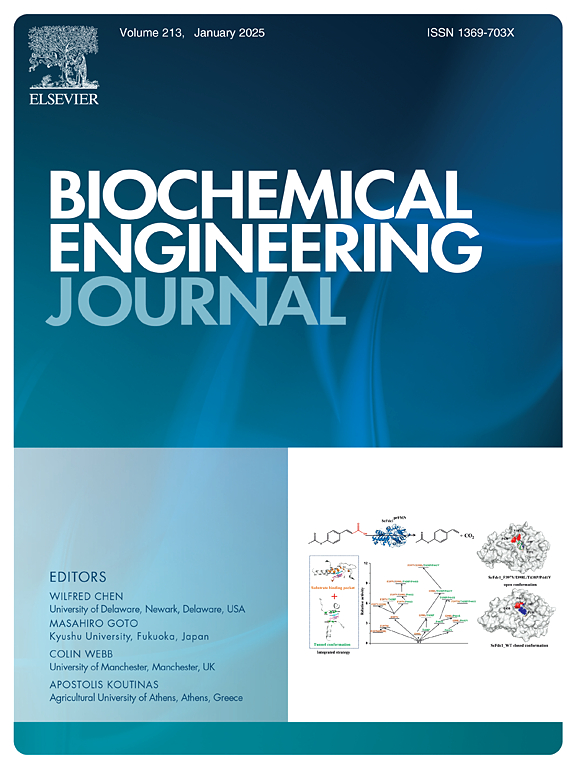Preparation of defective UiO-67 for CA immobilization to improve the ability of CO2 capture and conversion
IF 3.7
3区 生物学
Q2 BIOTECHNOLOGY & APPLIED MICROBIOLOGY
引用次数: 0
Abstract
Carbonic anhydrase (CA) has been suggested as a biocatalyst for carbon dioxide capture since it could effectively catalyze the hydration of carbon dioxide. Metal-organic frameworks (MOFs) have attracted significant attention in the development of immobilized enzyme carriers due to their pore tunability and excellent stability. In this study, UiO-67 materials with varying defect degrees (DUiO-67) were prepared using the organic linker missing method to enhance the catalytic performance. The results indicated that both the defect degree and the pore size of DUiO-67 materials decreased with an increase in acetic acid equivalent. After CA immobilization, all DUiO-67 materials exhibited excellent thermal, pH and recycling stability. CA@DUiO-67–25 showed higher enzyme catalytic activity and conversion ability than the other materials. After 10 cycles, CA@DUiO-67–25 retained 57 % of its initial conversion capacity. The construction of defective MOFs provides a promising new strategy for CA immobilization to achieve the catalytic conversion of CO2.
用于CA固定的缺陷UiO-67的制备,以提高CO2捕获和转化能力
碳酸酐酶(carbon anhydrase, CA)可以有效地催化二氧化碳的水合作用,因此被认为是二氧化碳捕获的一种生物催化剂。金属-有机框架(MOFs)由于具有孔可调性和优异的稳定性,在固定化酶载体的开发中受到了广泛的关注。本研究采用有机连接缺失法制备了不同缺陷度的UiO-67材料(DUiO-67),以提高其催化性能。结果表明:DUiO-67材料的缺陷程度和孔径随乙酸当量的增加而减小;CA固定后,DUiO-67材料均表现出良好的热稳定性、pH稳定性和循环稳定性。CA@DUiO-67 -25具有较高的酶催化活性和转化能力。经过10次循环后,CA@DUiO-67 -25保留了57 %的初始转化能力。缺陷mof的构建为实现二氧化碳催化转化的CA固定化提供了一种有前景的新策略。
本文章由计算机程序翻译,如有差异,请以英文原文为准。
求助全文
约1分钟内获得全文
求助全文
来源期刊

Biochemical Engineering Journal
工程技术-工程:化工
CiteScore
7.10
自引率
5.10%
发文量
380
审稿时长
34 days
期刊介绍:
The Biochemical Engineering Journal aims to promote progress in the crucial chemical engineering aspects of the development of biological processes associated with everything from raw materials preparation to product recovery relevant to industries as diverse as medical/healthcare, industrial biotechnology, and environmental biotechnology.
The Journal welcomes full length original research papers, short communications, and review papers* in the following research fields:
Biocatalysis (enzyme or microbial) and biotransformations, including immobilized biocatalyst preparation and kinetics
Biosensors and Biodevices including biofabrication and novel fuel cell development
Bioseparations including scale-up and protein refolding/renaturation
Environmental Bioengineering including bioconversion, bioremediation, and microbial fuel cells
Bioreactor Systems including characterization, optimization and scale-up
Bioresources and Biorefinery Engineering including biomass conversion, biofuels, bioenergy, and optimization
Industrial Biotechnology including specialty chemicals, platform chemicals and neutraceuticals
Biomaterials and Tissue Engineering including bioartificial organs, cell encapsulation, and controlled release
Cell Culture Engineering (plant, animal or insect cells) including viral vectors, monoclonal antibodies, recombinant proteins, vaccines, and secondary metabolites
Cell Therapies and Stem Cells including pluripotent, mesenchymal and hematopoietic stem cells; immunotherapies; tissue-specific differentiation; and cryopreservation
Metabolic Engineering, Systems and Synthetic Biology including OMICS, bioinformatics, in silico biology, and metabolic flux analysis
Protein Engineering including enzyme engineering and directed evolution.
文献相关原料
公司名称
产品信息
阿拉丁
p-Nitrophenyl acetate (p-NPA)
 求助内容:
求助内容: 应助结果提醒方式:
应助结果提醒方式:


